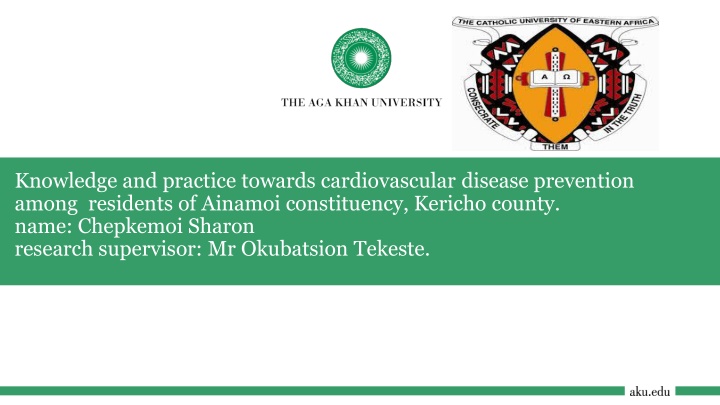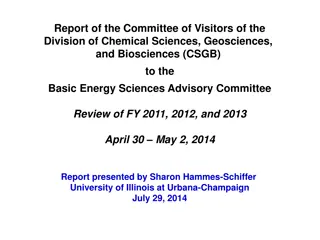
Knowledge and Practice on Cardiovascular Disease Prevention in Ainamoi Constituency, Kericho County
Explore the research on cardiovascular disease prevention in Ainamoi Constituency, highlighting the global impact of CVDs, research methodology, results on socio-demographic variables and dietary practices associated with CVDs. Gain insights into risk factors, knowledge on prevention, and behavioral patterns contributing to CVDs among residents.
Download Presentation

Please find below an Image/Link to download the presentation.
The content on the website is provided AS IS for your information and personal use only. It may not be sold, licensed, or shared on other websites without obtaining consent from the author. If you encounter any issues during the download, it is possible that the publisher has removed the file from their server.
You are allowed to download the files provided on this website for personal or commercial use, subject to the condition that they are used lawfully. All files are the property of their respective owners.
The content on the website is provided AS IS for your information and personal use only. It may not be sold, licensed, or shared on other websites without obtaining consent from the author.
E N D
Presentation Transcript
You may add your institutions logo Knowledge and practice towards cardiovascular disease prevention among residents of Ainamoi constituency, Kericho county. name: Chepkemoi Sharon research supervisor: Mr Okubatsion Tekeste.
INTRODUCTION. CVDs have become a major cause of disability and premature death throughout the world. WHO evaluation project that 17.9 million people died from CVD in 2016, representative of 31% of deaths globally. In Kenya, nearly 25%of hospital admissions and 13% of deaths are related to CVDs.(Ogino O. J et. al., 2011). Knowlege and practice on the risk factors modification can prevent clinical events and reduce the recurrent premature deaths in people with established CVDs.
Research Methodology. Study design: a descriptive community based cross sectional design was employed . A pre-tested WHO-structured questionnaire was issued out to 260 residents of various villages within Ainamoi constituency. Study population: Residents of Ainamoi constituency who met the inclusion criteria. Inclusion criteria:All adult residents of Ainamoi constituency. Exclusion criteria. Those who were aged below 18 years. Those who were very sick. Those who chose not to participate in the study Specific objectives. To determine : 1.Association between Socio- demographic variables and CVD risk factors. 2.Dietary practices associated with CVDs. 3. Knowledgeon on CVD prevention. 4.Prevalence of CVD risk factors. 5.Behavioural patterns associated with CVDs.
Results Association between Socio-demographic variables and CVD risk factors. Respondents totaling 260 were recruited in the study. (BP) A majority of respondents who were hypertensive were aged 41- 50 years,(38.5%) most of whom were male(31.5%) and majority were married.(33.7%) (BMI)obesity was highest among respondents with >50 years.(27.9%) A majority of those who were overweight were aged 41-50 years.(53.8%). A majority of the respondents with a high waist hip ratio and a high risk waist-hip ratio were aged less than 40 years.(47.8%,48.1%)respectiv ely. Furthermore, a majority of them were male and those who were married.
Dietary practice associated with cardiovascular diseases. Dietary practice Highest frequency Number(%) Sometimes White bread 119(45.8%) 127(48.%) 117(45%) Frequency of eating in a restaurant Type of bread chosen Frequency of consumption of fast foods Sometimes Not daily Sometimes Above recommended 4-7cups >7cups Sometimes 149((57.3%) 129(49.6%) 187(71.9%) Fruits consumption Frequency of nuts in diet Tea spoons of sugar per day 113(43.5%) 23(8.8%) 80(30.8%) Cups of tea per day Sugar contained beverages
Knowledge on cardiovascular disease prevention More than a half, (75.4%)of the respondents did not know the required amount of salt intake per day. 50.3% of them knew that too much salt in the diet could cause a health problem. More than half(76.5%)if the respondents did not know the required amount of sugar to be taken per day. 47.7%knew that too much sugar could cause a health problem. Most of those who knew the recommended amount of sugar had ever been advised to reduce sugar consumption.
Prevalence of cardiovascular disease risk factors. The prevalence of hypertension among the residents of Ainamoi Constituency was 36.2%. Pre-hypertension was 34.6%. Obesity - 24.6% High waist circumference - 47.7% High-risk waist-hip ratio - 40.8%
Relationship between Behavioral patterns and CVD risk factors. Hypertension prevalence was significantly higher among :smokers 52%(p=0.028), and those with interval<3hrs between dinner and sleep 96. 3%(p=0.028). Obesity was significantly higher among those who did not indulge in sufficient physical activity.(p=0.002). A majority of the respondents who took the salt above recommended amount had a high central fat accumulation 55%(p=0.017). The study found a significant relationship between daily fruit and vegetable consumption and a normal heart rate,(p=0.000,p=0.017) respectively. A majority of those who took the recommended amount of sugar had a normal heart rate 66%(p=0.015).
Conclusion The findings from this study show that there is high level of lack of knowledge on cardiovascular disease prevention, which is greatly attributable to the high prevalence of overweight and obesity, hypertension, high waist circumference and high-risk waist-hip ratio all of which are major risk factors for CVD development. The major predictors for developing CVDs among the residents of Ainamoi constituency include insufficient physical activity, consumption of salt and sugar above the recommended amount and consumption of fruits and vegetables less than the required amount. In light of this, Free CVD risk screenings and public health education should be done more frequently as residents expressed great satisfaction upon participating in the study.






















